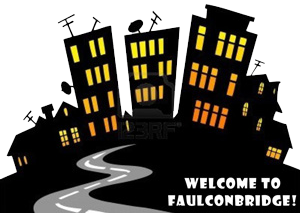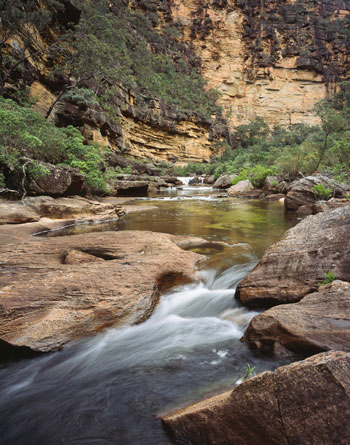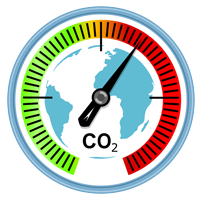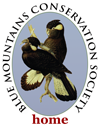


To address this in part, the Society has put together a list of "Asks" which it believes are both important and eminently do-able by any government genuinely committed to the environment.
However, please note, our "Asks" page is necessarily a work in progress as the Society finalises its position on key issues as well as adjusting "Asks" as the Government makes legislative and regulatory changes on its way to the March 2015 election.
So what are the Society's current "Asks" of the NSW Government? Please read on . . .
National Parks & Conservation Reserves - Threatened Species
Mining and CSG - Climate Change and Renewables - Waste Management
 Not another suburb of Sydney
Not another suburb of Sydney
1a. Society Ask: Protect the Blue Mountains from urban sprawl and over development.
Support the recently exhibited draft Blue Mountains Local Environmental Plan.
Background: If the planning protections contained in the current Blue Mountains Local Environmental Plan (BM LEP) and in a recently revised draft of that LEP are removed, the bushland that surrounds our towns and villages will be opened up to urban sprawl. This will result in vast areas of bushland within and outside the World Heritage listed National Park being cleared for bushfire protection purposes with major impacts on threatened species, waterways and the natural environment in general. Only the strong planning rules in the current and revised draft version of the BM LEP will prevent such a major loss for the World Heritage listed Blue Mountains.
1b. Society Ask: Protect the Blue Mountains from urban sprawl and over development.
Delete the Blue Mountains as an identified Metropolitan Urban Growth Area in the Draft Metropolitan Strategy for Sydney.
Background: The NSW Government has drawn up a growth plan for Sydney which identifies areas to target for urban growth. The Blue Mountains has been identified as a “Metropolitan Urban Growth Area” in the Draft Metropolitan Strategy, extending Western Sydney as far as Linden and out to the edge of its World Heritage listed National Parks. Beyond that the Blue Mountains is identified as “rural villages” which can also be targets for growth. If not changed, the plan would result in excessive urban sprawl in a highly environmentally sensitive and bushfire prone environment. The Blue Mountains is not an extension of the ever expanding western Sydney region and should not be opened up to urban sprawl. It is highly inappropriate that it has been identified as a Western Sydney regional growth area.
1c. Society Ask: Endorse the Community Charter drawn up by the Better Planning Network and adopt the details as listed in the Community Charter Companion.
Background: The Community Charter - Planning for People: A Community Charter for Good Planning in NSW sets a community vision, key principles and desired outcomes for good planning in NSW. The Charter is accompanied by a Companion document that details these principles and outcomes, as well as some of the mechanisms through which the Charter could be implemented. It has been developed for use by a wide range of groups and individuals in the lead-up to the NSW Elections in March 2015, to put the need for good planning on the agenda of voters and candidates.
 Better bushcare business
Better bushcare businessbrings benefits.
2a. Society Ask: The Blue Mountains volunteer bush regeneration program lacks a specific quick response capability for urgent/unforeseen tasks, therefore an "Instant Action" fund of $50,000 per annum is needed.
Background: The Community Conservation Program is well run by both Council Officers and Volunteer Group Coordinators. This coordinated effort to manage the natural resources of Blue Mountains LGA is also supported under a prioritised Catchment-focused model by Greater Sydney Local Land Services and others through grants.
However there are significant opportunities to save money overall through such a fund as envisaged. For example, while Council manages natural disasters on the wider scale, and smaller problems over a longer time scale, there are often circumstances where prompt action on a small issue will save time and money in the long term. This might involve the engagement of a professional contractor for a day to remedy an unexpected discovery of flowering weeds, or the procuring of a small amount of material to stop erosion beginning. This proposed fund would be spread over more than 50 volunteer groups in the Blue Mountains, so any individual "spend" would be necessarily small.
Any use of the fund would be on a registered volunteer worksite. Decisions on the implementation of any ideas would be coordinated with the responsible professional Bushcare Officer for a site. Accountability and management of the fund would need to be established, but should be as simple as possible.
2b. Society Ask: The State Government could assist by establishing a centralised database for all agencies to record weed removal projects.
Background: Council has invested heavily on a tenure-blind catchment and landscape-type management system. Volunteers need to be apprised of weed control projects by other stakeholders on a real-time basis so as to maximise overall efficiency.
While the overall management of each volunteer worksite is programmed for up to 12 months in advance, decisions on what is to be done on any particular workday are typically left to the Bushcare Officer and Volunteer Co-ordinator at the beginning of each work period, having taken into account the risk management survey, including weather. The potential efficiency improvements available by having current knowledge of work being done (or not being done!) on a neighbouring property will be obvious to anyone who has worked uphill to remove a weed plume, only to find the stakeholder on the other side of the fence has not been doing the same. It takes little time for the same weeds to re-invade the cleared volunteer site.
So, some form of easily accessible database or information sharing - surely not difficult in this day of smart phones and the like, would be cheap (or "free"), would increase overall efficiency and also satisfaction, particularly for volunteers. What would be needed is an overall (State Government) directive or similar to make this happen.
Potential stakeholders include:
- Highway/RMS
- Railway
- Council
- Local Land Services
- National Parks
- Private landholders (this might sound difficult, but many private landholders are already involved by way of the Bush Backyards program and other environmental groups).
 Protect the Gardens of Stone
Protect the Gardens of Stone
3a. Society Ask: Protect the Gardens of Stone on the western escarpment of the Blue Mountains by creating new reserves over this spectacular pagoda landscape.
Background: The Gardens of Stone is a pagoda wonderland of majestic coloured cliffs, slot canyons, old growth forest, unique swamps and grassy woodlands. While it includes the World Heritage Gardens of Stone National Park, created in 1994, and Mugii Murum-ban State Conservation Area (since 2011), other parts such as Ben Bullen State Forest and Newnes Plateau adjoin national parks but are not protected from threats like open cut coal mining.
The Gardens of Stone Stage 2 Reserve Proposal identifies 40,000 hectares of this spectacular landscape which could be conserved mostly as State Conservation Areas. The area is easily accessible for recreational uses such as walking, camping and 4WD driving on gazetted roads and expands the existing multi-million dollar tourism activities into the western Blue Mountains.
3b. Society Ask: Base funding and staffing levels for NSW National Parks should be returned to at least 2013-2014 levels, adjusted for both inflation and new areas added to the estate. Furthermore, supplementary funding and staffing are needed to address: the many new trial programs staff are having to coordinate, and the growing threats posed by climate change, rapid feral animal population growth, and noxious weeds.
Background: During its term the current NSW Government upgraded a number of conservation/reserve areas to National Park status (Dharawal in March 2012 and Berowra Valley in November 2012) and expanded the Nattai Wilderness significantly in April 2014 - all commendable actions.
On 17th June 2014 the NSW Government released a statement to the media that listed the many millions of dollars it was spending on the environment, with national parks being prominently mentioned. However, a closer examination of the 2014-2015 budget papers reveals quite a different story for our national parks. Operating expenses for the 2014-15 budget year have actually been cut by 16% compared to 2013-2014 allocations, capital expenditure cut by 10.5%, and staff are to be reduced by 35 full-time equivalent positions.
These cuts come at a time when the National Park estate has actually increased slightly and National Parks' staff are having to manage trials of hunting, logging, and grazing on top of their normal duties, as well as manage the introduction of horse riding and mountain biking with attendant costs for trail construction, signage, and supervision. In addition, our National Parks are suffering increasing damage from climate change, rapid growth of feral animal populations, and weed infestations - all at a time when the government is promoting increased human visitation.
This is the time for funding and staff increases, not cuts. As the Greater Blue Mountains area comprises mostly National Parks such increased funding is all the more important to our community.
 No Hunting in National Parks
No Hunting in National Parks
3c. Society Ask: No Hunting in National Parks.
Background: In May 2012, the State Government agreed with the Shooters Party to allow recreational hunting under control of the Game Council in 79 National Parks.
After considerable public opposition and an inquiry into the Game Council's operation, this proposal was changed in July 2013 to allow hunting under the supervision of NPWS staff in 12 National Parks.
While this was an improvement, the initial trial has shown that the program is an expensive and ineffective way to deal with the problem of feral animals. The majority of animals shot have been rabbits at a cost of over a hundred dollars per rabbit. This is at a time when budgets are stretched and effective programs are struggling for resources.
This 'quasi' program should be scrapped in favour of evidenced based and cost effective methods to address the problem of invasive species.
 Protect the Wollangambe
Protect the Wollangambe
3d. Society Ask: Protect the Wollangambe - the Blue Mountains Wild River.
Ensure that the Clarence Colliery does not discharge environmentally harmful water into the Wollangambe.
Background: The Wollangambe is a declared wild river. It is just to the north of Mt. Wilson and for most of its length it is within the Blue Mountains and Wollemi National Parks and the Wollemi Wilderness.
Wastewater discharged by the Clarence Colliery is polluting the Wollangambe River. The wastewater increases salinity, metals, pH and water temperature. Macro-invertebrate abundance was more than 90% lower downstream of the coal mine discharge point.
The colliery is subject to an Environment Pollution Licence (EPL). The previous EPL was inadequate and is currently being reviewed. This licence and all colliery licences need to protect the surrounding water, land and wildlife.
 Gang-Gang Cockatoo (male)
Gang-Gang Cockatoo (male)
4a. Society Ask: In order to protect the many rare and threatened species of the Greater Blue Mountains World Heritage Area (GBMWHA) the NSW Government must significantly increase both funding and staffing at the local National Parks and Wildlife Service (NPWS) level.
A 15% increase on the 2013/14 base funding/staffing levels (not the reduced funding/staffing proposed for 2014/15) would be the bare minimum required to make any real difference, but more is urgently needed.
Background: The GBMWHA is listed at the international level for its outstanding biodiversity which includes very high numbers of rare and threatened species. These species are under enormous pressure from many factors; notable among these is climate change and the attendant rise in frequency and intensity of fires, but there are many more including rapid growth of feral animal populations, water pollution, habitat degradation through weed infestations, and the list could go on.
While the federal government has an international obligation to ensure "the identification, protection, conservation, rehabilitation and presentation of the GBMWHA and its transmission to future generations" it is the Office of Environment and Heritage (OEH) at the state level, particularly the NPWS, who undertake the day to day management of the area. There must be sufficient funding and staffing of the NPWS to allow its staff to be proactive rather than just reactive in their management of the eight reserves that comprise the vast GBMWHA.
The capacity of the local NPWS to undertake research and biodiversity monitoring seems to be very limited, if not non existent. There are no rangers based at Glenbrook any more and we are not aware of any "naturalist" positions within the GBMWHA. The number of local species that are threatened continues to increase, precisely why we mostly don't know because sufficient research is simply not happening. If GBMWHA biodiversity is to be preserved, the local NPWS needs an urgent increase in staffing and funding levels, we estimate a 15% increase on 2013/14 levels to be the bare minimum required.
5a. Society Ask: The NSW Government should impose a moratorium on all CSG operations in NSW until such time as the full framework of safeguards recommended in the NSW Chief Scientist's final CSG Report (30th September 2014) is put in place.
Further, as even the best safeguards will on occasion fail, well mapped CSG "no-go" zones are needed in perpetuity to protect catchments, prime agricultural land, and significant environmental areas.
Background: On the 25th September 2014 the NSW Energy and Resources Minister Anthony Roberts announced an extension of the moratorium on new CSG exploration licences by 12 months (i.e. until September 2015). Just five days later on 30th September the NSW Chief Scientist, Professor Mary O'Kane, released her final report on CSG in NSW. This report has confirmed many of the risks pointed out by both agricultural and environmental groups over the last few years.
Further, the report states that for CSG extraction to be safe it needs to occur within a tightly monitored and regulated framework.
The Chief Scientist makes 16 recommendations to facilitate such a framework, but even with these admits that "There are no guarantees" and that "it is inevitable that the CSG industry will have some unintended consequences". She states further that "Implementing the recommendations of the Review involves non-trivial tasks".
Clearly until these non-trivial tasks are accomplished we need a moratorium on more than just new exploration licences, we need a moratorium on all CSG operations. Also, as the Chief Scientist admits, there will be accidents. There are some areas where accidents simply must not happen at all, therefore there is an urgent need for water catchments, prime agricultural land, and environmentally significant areas to made CSG "no-go" zones immediately and in perpetuity. These areas are well known to all concerned.
5b. Society Ask: Legislation should be enacted to exclude mining and gas extraction from prime agricultural land and environmentally significant areas.
Beyond these "No-Go" zones, areas should be assessed on the basis of environmental, community, and economic considerations; economic gains must not be the "principal consideration".
Background: Prior to the 2011 election assurances were given that, subject to scientifically based assessment and mapping, prime agricultural land and environmentally significant areas would be protected from mining and CSG activities, that is they would be "ring-fenced".
However, the Regional Land Use Plans that eventually emerged offered no such protection. The NSW Nature Conservation Council noted that: "In an extraordinary reversal, the NSW Government has removed basic protections for rivers, forests and critical wildlife habitat that were proposed in the draft land use plans. This backward step will leave iconic natural areas like Leard State forest and the Pilliga exposed to the destructive impacts of unprecedented mining and gas expansion.", and these destructive impacts are exactly what has happened. With the exception of a few horse studs and vineyards no areas in NSW were adequately protected.
The Gateway processes that were put in place clearly favoured mining and gas extraction over agricultural production and the environment. Further, in November 2013 the Government tabled legislation to make the economic benefits of large mining projects the "principal consideration" in assessments, trumping adverse social and environmental impacts.
None of this is what was promised, none of this is fair or reasonable; NSW deserves a better framework to protect our farms and our environment.
 No ifs, no buts, our catchments
No ifs, no buts, our catchmentsmust be protected.
5c. Society Ask: Legislation should be enacted to ban both mining and gas extraction from all designated water catchment areas, as well as a similar ban on mining and gas extraction within one kilometre of significant water ways that feed these catchments.
Background: Prior to the 2011 state election the Leader of the Liberal Party and subsequent Premier of NSW promised that "The next Liberal-National Government will ensure that mining cannot occur . . . in any water catchment . . . no ifs, no buts, a guarantee."
Unfortunately this promise was not kept, but the reality of the threat is abundantly clear: radioactively contaminated water from CSG drilling has been released in the Pilliga, creek beds have been cracked from longwall mining with consequent water pollution and loss, and the list could go on. Yet the current NSW government has only temporarily suspended CSG drilling in Sydney and Illawarra water catchment special areas, just a month after having blocked cross-bench initiated legislation that would have actually protected catchments from CSG. In Sydney alone, 4.5 million people depend on clean water from our catchments.
5d. Society Ask: The Member for the Blue Mountains should actively, and publicly, seek the removal of AGL's CSG exploration licence (PEL2) from all lands within the Greater Blue Mountains area.
Background: In late 2012 the local member for the Seat of Blue Mountains, Roza Sage, was presented with a petition from more that three and half thousand Blue Mountain's residents calling on her to "Advocate, both in NSW State Parliament and directly with AGL, for all lands within the Greater Blue Mountains area, including the BMCC area, to be immediately removed from AGL's Petroleum Exploration Licence (PEL2)."
Since that date another far less threatening application for an exploration licence (PELA 158) has been refused.
However, the real and more imminent threat of AGL's PEL2 remains in place over the Blue Mountains and no advocacy from our local member for PEL2's removal has been evident. As recently as September 2014 there have been confirmed reports of gas leakages, significant enough to necessitate Fire Brigade intervention, from an AGL CSG operation at Camden.

6a. Society Ask: Legislation should be enacted at the state level to mandate a 20% renewable energy target by 2020 for NSW.
Background: After years of bi-partisan political support the Federal Government in Canberra is now showing little commitment to maintaining the nation's 20% Renewable Energy Target (RET) by 2020. In fact, the Federal Government commissioned a RET review report that has recommended, unsurprisingly given the hand picked authors, a slashing of the RET. This has thrown into chaos renewable energy infrastructure projects worth billions of dollars, and will result in many thousands of potential jobs failing to materialise.
When the federal government repealed the carbon tax in July, the New York times stated that "Australia’s energy policy is now essentially in shambles" - undermining the RET does nothing to improve this "shambles". In April 2014 the NSW Government in its submission to the federal Renewable Energy Target (RET) review gave in principle support for the RET, but recommended delaying the large scale component and reducing incentives for rooftop solar.
NSW needs to go beyond qualified "in principle" support. Rather, in the interests of mitigating climate change, supporting long term sustainable infrastructure, and protecting jobs, NSW should legislate at the state level for a 20% RET by 2020. In July 2014 state Environment Minister Stokes pledged to make NSW "Australia's answer to California" for clean energy, and in September 2014 the Labor opposition reiterated its support for a 20% state level RET. Clearly the promises align, so there is nothing stopping a 20% state level RET before the next election - just do it.
6b. Society Ask: Legislation and regulations are needed in NSW to establish policy consistency and fairness for solar feed-in tariffs.
Such tariffs should be mandatory for suppliers, not optional, and should be set at a "fair" level that is directly linked to supplier prices.
Background: More than 350,000 households in NSW have installed arrays of solar photovoltaic panels. These arrays have many benefits: they reduce electricity demand from fossil fuel power plants thereby reducing carbon emissions; they produce in-situ power reducing the load on the distribution network (the poles and wires) thereby reducing infrastructure costs; and the ongoing maintenance and repair costs of these power producing arrays is borne by the array owner not the state.
However, over the last 5 years we have seen significant confusion in feed-in tariff policy from both Labor and Coalition NSW governments. First the original excessively generous gross feed-in tariff was cut for new users, then cut for all users but then reinstated for existing recipients, the new lower rate was then closed to newcomers, and then a regime with an even lower rate (to be paid by the electricity supplier) was introduced, but the recommended rate was purely optional for suppliers, with many suppliers simply ignoring it.
The result today is some households get 60c per kWh, some get 20c, some depending on their supplier may get 6c or 7c but only on net feed-in, and many get nothing at all - lacking the leverage to negotiate any deal whatsoever with their supplier.
Such a system is inequitable, open to profiteering by suppliers, fails to encourage people to make a personal investment to mitigate climate change, and singularly lacks policy good sense.
Legislative and regulatory changes are urgently required to mandate a minimum feed-in tariff which all suppliers must offer to their customers. This feed in tariff must be "fair" by taking into account all externalities, particularly the environmental costs of fossil fuel produced power.
Rather than a simple fixed rate in cents, we recommend a rate directly linked to a supplier's own prices, either by a set difference in cents, or using a percentage.

7a. Society Ask: The City of Blue Mountains generates a large volume of waste to Landfill, waste that could be reduced significantly through sorting, recycling, composting, and thermal treatment.
NSW State Government funding is needed to support local government in this project.
Background: The City of Blue Mountains generates large volumes of waste to Landfill. Much of this waste is material that could be recycled, composted, or thermally treated to extract energy, make biochar, and capture carbon. While we have a recycling program, it does not achieve 100% capture of all recyclables, and very little ‘green’ waste (kitchen and garden waste) is diverted.
Technologies exist to sort the waste stream. Technologies exist to compost the green waste. Technologies exist to thermally treat much of the rest. Blaxland Landfill will be full in 2025. Noxious smells are released from it today. All of this can be fixed through the application of a relatively small amount of money (circa $20m) and some ingenuity.
